|
October 22, 2020
I hope that you and your loved ones are doing well, staying healthy, and looking out for your neighbors and friends in these difficult times.
Our COVID situation in Oregon remains pretty much where it has been. The just-released weekly report shows a slight decrease in the number of new cases and makes clear that the hoped-for large increases in testing have not yet come. You can read more about the report below.
We do see a large number of deaths reported today: eleven, a large daily increase for Oregon. To some extent, that’s a function of when deaths are reported: 4 of those deaths were those from Eastern Oregon who were at a hospital in Boise and died over a two-week period. But it’s also the result of the larger number of COVID cases that we’ve been seeing over the last 4-6 weeks.
The news is better with respect to firefighting. The Department of Forestry reports that containment of the Lionshead Fire in the Cascades west of Warm Springs has increased by more than 20% over the last 24 hours or so.
Please let me know if you have any questions about anything in this newsletter.
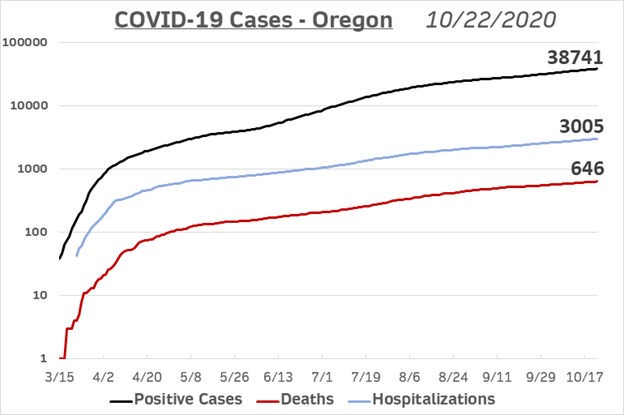
TODAY’S CORONAVIRUS AND CORONAVIRUS RESPONSE UPDATE
-
Positive Cases: OHA reports that 335 additional Oregonians have tested positive for COVID. The cumulative total since the beginning of the pandemic is 38,741.
-
Total Tests: The number of reported tests has increased by 6,034. The cumulative total is now 803,932.
-
Ratio: The percentage of positive test results today is 5.6%. The national ratio today is 6.7%.
-
Deaths: I regret to have to report 11 additional deaths due to the coronavirus today. You can read more about the Oregonians we lost further down in the newsletter. The total number of COVID deaths in Oregon is now 646.
-
Hospitalized: OHA reports an additional 16 COVID hospitalizations today. The cumulative number of those who have been hospitalized with COVID is now
-
Presumptive Cases: OHA is including “presumptive COVID-19 cases” in its daily reports, consistent with recently amended guidance from the Centers for Disease Control and Prevention. A presumptive case is someone who does not yet have a positive PCR test but is showing symptoms and has had close contact with a confirmed case. If they later test positive by PCR, those will be recategorized as confirmed cases. OHA reports 38 new presumed positive cases today. The total number of those counted as presumed positives is 2,069.
-
Other Hospital Information:
- Patients Currently with COVID-19 Symptoms (who may or may not have received a positive test result yet): 194 (11 more than yesterday). Of those, 140 have already received a positive test back.
- Available ICU Beds: 162 (9 more than yesterday)
- Other Available Beds: 572 (13 fewer than yesterday).
- ICU Patients w COVID-19 Symptoms: 55 (2 fewer than yesterday).
- COVID-19 Patients Currently on Ventilators: 21 (same as yesterday).
- Available Ventilators: 785 (15 more than yesterday).
-
Dashboard:
-
Today’s National Numbers:
-
Additional Brief Updates:
- The Oregon Emergency Management Department is encouraging survivors of the wildfires to take advantage of the FEMA rental assistance program. This program provides survivors a grant to pay for somewhere to live while they work on permanent housing plans such as repairing or rebuilding their home. They can use this grant to rent an apartment, house, or recreational vehicle that can keep survivors near their jobs, schools, homes, and places of worship. Here is information about the program in English and in Spanish.
- OHA has issued new guidance allowing bowling alleys and skating rinks to reopen in Phase One counties as long as they meet requirements regarding face coverings and social distancing. You can read the new guidance here.
- You’ll see in today’s newsletter that four more Oregonians (residents of Baker and Malheur Counties) have been reported to have died in St. Alphonsus Hospital in Boise. (These were presumably reported as a group today, though they occurred over the last couple of weeks.) It makes sense that Oregonians who live close to Idaho would go there for care. That may be ending soon, however. The Oregonian has a story about the toll that the pandemic is taking on Idaho hospitals, which are likely going to have to start sending patients to Portland and Seattle as they are reaching their limit on available beds.
-
The Oregonian’s Jamie Goldberg has an article about the challenges that local governments face in identifying recipients and getting rent relief payments out to those most in need. Those funds must be expended by the federal deadline that comes at the end of December.
Latest OHA Weekly COVID Report Released
OHA released its WEEKLY COVID REPORT yesterday. It is again a very comprehensive snapshot of different aspects of transmission of the disease in Oregon over the past week or so. It confirms what we’ve been seeing in our daily reports: an ongoing increase of transmission in Oregon, with increases in new infections, accompanied by declining testing and increases in test positivity, hospitalizations, and declining deaths. It continues to show ongoing disproportionality among racial and ethnic groups.
Here are some of OHA’s broad observations of where we are now, based on data from October 12-18:
- We see a slight decrease in the number of new cases. Last week OHA recorded 2,327 new cases of COVID-19 infection—down 4% from last week’s record-high tally of 2,418.
- The cumulative statewide infection rate is now 939 cases per 100,000 Oregonians.
- The number of tests reported improved again, but only slightly: by 1.6% to 28,960. This is still below where we should be, but with the increasing tests and supplies coming from the federal government, we should be seeing further improvements next week.
- The percentage of positive test results again rose slightly, from 6.4% to 6.5%.
- Last week the number of reported deaths rose slightly from 25 to 27.
- The cumulative death rate since the beginning of the pandemic is now 14.8 deaths per 100,000 Oregonians, with a cumulative total of 599 on October 11. This again constitutes a mortality rate of 1.6% of reported cases.
- The number of new COVID hospitalizations went down slightly last week, 143 vs. the previous week’s 147. However, this remains a very high number compared to where we were at the end of the summer.
- The age group with the highest incidence of reported infection continues to be 20–29-year-olds, with rates decreasing in subsequent decades of life.
The report again provides information about signs, symptoms, and risk factors; racial/ethnic/age/gender demographics; recovery; outbreaks in long-term care; workplace outbreaks; outbreaks in childcare centers and schools; hospital rates; and the breakdown of cases by zip code.
Racial/Ethnic
The report again demonstrates significant disparities among racial groups. You can see this in the charts below, with data that I’ve taken from the October 4 report, the October 11 report, and from this report. It allows you to see at a glance the proportion of case counts within different racial groups and ethnic groups (technically, “Hispanic” is not a race and is counted as an ethnic group, with numbers from a separate chart). They remain relatively stable.
To help you understand the racial/ethnic data reported in the weekly report, I’ve also created a new chart that shows the hospitalization and death rates per 100K population, along with the infection rates per-100K population for each racial/ethnic group.
You’ll see again how much higher the case rates per 100,000 are for most racial/ethnic groups compared to White Oregonians. Black Oregonians are 3.4 times more likely to contract the disease than are White Oregonians, Native Americans 4.1 times more likely, Latinx Oregonians are 5.7 times more likely, and Pacific Islanders are now 8 times more likely. The differences, while still enormous, have continued to go down slightly from week to week.
You’ll also again see that hospitalization rates among those who have contracted the disease are somewhat lower for Blacks and Native Americans, quite a bit lower for Latinx, and quite a bit higher for Pacific Islanders than for the population of White Oregonians. Among those who have contracted the disease, the percentage who ultimately die of it is much higher for Whites than for people of color.
However, you’ll also see in the final chart that when examined as a proportion of their populations in Oregon, the hospitalization and death rates for Blacks, Native Americans, Pacific Islander, and especially for Latinx Oregonians continue to be disproportionally high. It helps us to see why it’s so important that special outreach needs to be made to members of these racial/ethnic groups.
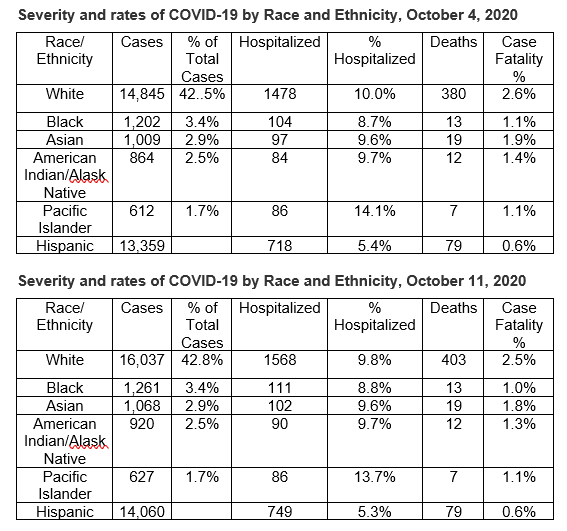 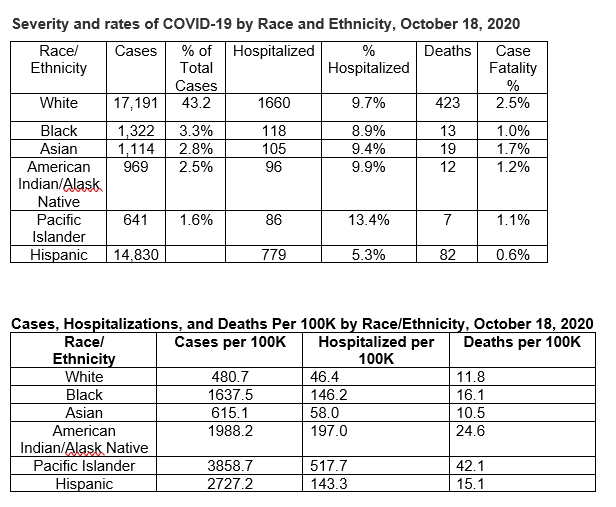 The weekly report includes graphs showing how Public Health agencies are doing in contact tracing for different racial and ethnic groups. For the most part, the rate of follow-up interviews with Oregonians of color appears to be comparable to the rate with White Oregonians (actually, higher among Latinx Oregonians). Those attempts are less successful for Black Oregonians.
Outbreaks at Long-Term Care Facilities
The report lists outbreaks at long-term care facilities with more than five residents that have three or more confirmed cases or at least one COVID death. Fortunately, we are seeing a continued reduction in active outbreaks in these facilities.
This week’s report lists outbreaks in 52 (up from 40) long-term care facilities that are still considered active. They are responsible for 634 cases (down from 709) and 38 deaths (down from 54).
In addition, there are 77 outbreaks considered resolved (up from 75). They are responsible for 1,227 cases (up from 1,079) and 132 deaths (up from 109). To be listed as a “resolved” outbreak, a facility must not have had a new case in at least 28 days.
In addition to the listed facilities, there are now 62 (up from 53) congregate settings with five or fewer beds that have also had three or more confirmed cases or one or more deaths..
Facilities that have been in “resolved” status for 56 days are being dropped from that list.
I’m pleased to report that OHA is now including the cumulative totals in these weekly reports, so that we can see the true cumulative totals of all congregate cases and deaths since the beginning of the pandemic (i.e., including those on the current active list, the current resolved list, those too small to be listed, and those that have been moved off of the resolved list and are archived.
OHA reports that to date, there have been 3,606 cases and 363 deaths associated with congregate care settings. That’s 58% of the cumulative deaths reported as of last week.
To date, there has still been only one death of a staff member reported.
Workplace Outbreaks
Similarly, there are separate listings for workplace outbreaks that are “active” and “resolved,” but without deaths identified by workplace. Case counts include all persons linked to the outbreak, which may include household members and other close contacts. To protect privacy, OHA is only reporting workplace outbreaks with five or more cases (workers and family members) and only for workplaces with at least 30 workers. They are listed in descending order of number of cases.
You’ll find 77 workplaces (up from 73 last week) listed as “Active” this week, totaling 2,787 (up from 2,645).
A facility goes onto the resolved list once it has not had a new case in 28 days.
35 workplaces (down from 45 last week) are now listed as “Resolved,” totaling 554 cases (down from 696 last week).
As is the case with the congregate living lists, once a workplace outbreak has been in resolved status for 56 days, it is dropped from the list.
As is the case with the congregate living lists, OHA is now reporting cumulative cases since the beginning of the pandemic. There have been 29 deaths (up from 24 last week) and 7,882 cases associated with all workplace outbreaks that have been reported to date.
Three out of the top four workplace outbreaks in Oregon today are again in Eastern Oregon state prisons. There are currently five prisons on the active list. They again make up 42% of all the active workplace outbreak cases.
Childcare Outbreaks
OHA has changed the way that it reports outbreaks in childcare facilities. Previously, the Weekly Report only included names and case counts for childcare facilities that enroll 30 or more children and have five or more cases. They are now reporting all outbreaks that include two or more cases in facilities with more than 16 children.
There are now 11 (up from 9) facilities listed as active. They comprise a total of 58 cases (up from 50). One center that was previously on the active list has been more to the resolved list; three new centers have been added.
These case counts may include children, staff, and household members.
Four centers are now on the Resolved list, comprising 38 (up from 33) cases.
In addition to the listed centers, there are again 13 child care facilities that serve 16 or fewer students that have outbreaks of 2 or more cases.
Cases in K-12 Schools
OHA is now reporting all COVID-19 cases in schools that offer in-person instruction, distinguishing between students and staff. The report lists schools with at least 30 students that have at least one reported COVID case.
The new reporting protocol applies to all public and private schools and programs.
This week’s report on schools with in-person instruction shows 16 (down from 17 last week) cases of students and 24 (down from 35) cases of staff members at a total of 21 (down from 25) public and private schools (including elementary, middle, and high schools) around the state.
Nine schools have now been moved into the newly-created “Resolved” category, meaning that it’s been more than 28 days since a new case was reported. They comprise 4 students and 13 staff members.
Infections by Zip Code
You’ll see that the zip code list again reveals the various hot spots around the state, presented in terms of cases per 100K residents since the beginning of the pandemic. Since these are cumulative totals, change in zip code rankings happens slowly over time.
The top five are exactly the same (from Umatilla/Morrow, Jefferson, and Malheur Counties) as they’ve been for the last month:
- 97818 (Boardman in Morrow County)
- 97761 (Warm Springs in Jefferson County)
- 97914 (Ontario in Malheur County)
- 97838 (Hermiston in Umatilla and Morrow Counties)
- 97882 (Umatilla in Umatilla County)
97913 (Nyssa in Malheur County) remains in the on-deck spot at #6.
Here is a zip code locator for you to use as you look at the zip code numbers.
The Oregonian has created an interactive map of cases by zip code. It allows you to see COVID cases both cumulatively and with changes over the last week.
Again: Legislature’s Emergency Board Meets on Friday
The next meeting of the E-Board is scheduled for Friday at 1 p.m. Here is a link to the agenda, meeting materials, and access to live or recorded video.
Here are the items on the agenda for Friday:
-
Project Turnkey: A potential allocation of $65 million for Project Turnkey, an effort to address the need for more transitional housing in Oregon. Instead of renting spaces for those needing emergency or short-term housing, it would allow social service providers and local governments to purchase hotels and motels to help address ongoing needs. The E-Board will be hearing two proposals for starting this program, one focused on pandemic response, the other on wildfire response.
-
Expanded Shelter for Wildfire-Affected Areas: This will allocate an additional $10 million to Housing and Community Services to address immediate needs, with a focus on wildfire-affected areas.
-
Smoke-Damaged Schools: This will allocate $7,439,727 of the $20 million that the E-Board set aside at its last meeting to help districts get their smoke-affected schools ready for reopening. This specific allocation is the result of specific requests from individual districts in need.
-
Statewide Alert System: This will appropriate $1,400,000 to create a statewide emergency alert system. Experiences during the wildfires made it clear that we need a better, more coordinated system.
-
Wildfire Debris Removal: This will appropriate $50 million to ODOT for expenses related to removing ash and debris from roadways around the state. In addition, ODOT will be allowed to spend up to $295.7million of its reserves for hazardous tree removal. The state should eventually be able to recover at least 75% of these expenditures from FEMA.
-
Coronavirus Relief Fund and CARES Act Expenditures Report: DAS will be presenting its review of the state’s use of federal CARES Act and CRF funds over the last 6 months.
You’ll find details on each of the proposals in the meeting materials section of the meeting.
Please let me know if you have any questions.
Thursday Wildfire Recovery/Response Update
ODF reports another small increase in containment of the Slater Fire in Northern California and Southwestern Oregon and a large increase (from 46% to 67%) in the Lionshead Fire in the Cascades west of Warm Springs. As I reported yesterday, the Beachie Creek Fire in Marion County is now 85% contained (up from 80%). The containment levels of the other three fires remain where they’ve been, with high levels of containment.
 Again, for maps and up-to-the-minute details on the individual fires, I’d direct you to OEM’s State of Oregon Fires and Hotspots Dashboard.
The Oregon Emergency Management provides us with updates on Mondays, Wednesdays, and Thursdays, so the statistics below are all the same as yesterday’s.
- The number of fatalities (9) and missing persons (1) remains the same.
- The number of residences reported destroyed is 4,008. More than 1,400 structures other than residences have also been destroyed.
- EPA and FEMA’s work on Household Hazardous Waste removal in Jackson County is underway.
- According to the Red Cross, 1,840 Oregonians remain in emergency housing (20 fewer than Monday). Of those, 88 are living in RVs and tents, and 1,752 are in hotels/motels and other short-term settings. There are no evacuees living in indoor congregate shelters any longer.
- The number of Oregonians who have registered with FEMA for individual assistance has continued to increase and is currently at 21,793. FEMA has already approved for $20.69 million in assistance grants.
- Still, if you know of anyone who has NOT yet registered, please direct them to the following:
Where Are Today’s New Cases?
If we put together the positive test results and new “presumptive” cases reported today, the overall number of new cases for today is 373. Here is the breakdown by county for today:
Benton (6)
Clackamas (25)
Clatsop (3)
Columbia (2)
Coos (2)
Crook (6)
Deschutes (13)
Douglas (8)
Harney (3)
Hood River (1)
Jackson (31)
Jefferson (2)
Josephine (3)
Klamath (3)
Lane (29)
Linn (6)
Malheur (18)
Marion (37)
Multnomah (81)
Polk (3)
Umatilla (13)
Union (6)
Wasco (10)
Washington (59)
Yamhill (4)
And the Deaths:
Oregon’s 636th COVID-19 death is an 83-year-old man in Baker County who tested positive on Oct. 4 and died on Oct. 18, at St. Alphonsus Regional Medical Center in Idaho.
Oregon’s 637th COVID-19 death is a 74-year-old man in Malheur County who tested positive on Aug. 26 and died on Oct. 13, at St. Alphonsus Regional Medical Center in Idaho.
Oregon’s 638th COVID-19 death is a 77-year-old man in Malheur County who tested positive on Sept.15 and died on Oct. 6, at St. Alphonsus Regional Medical Center in Idaho.
Oregon’s 639th COVID-19 death is an 87-year-old woman in Multnomah County who tested positive on Sept. 24 and died on Oct. 11, in her residence.
Oregon’s 640th COVID-19 death is a 94-year-old woman in Lane County who tested positive on Sept. 24 and died on Oct.4.
Oregon’s 641st COVID-19 death is a 96-year-old woman in Washington County who tested positive on Oct. 6 and died on Oct. 20, in her residence.
Oregon’s 642nd COVID-19 death is an 84-year-old woman in Linn County who tested positive on Oct.12 and died on Oct.15, in her residence.
Oregon’s 643rd COVID-19 death is a 53-year-old man in Umatilla County who tested positive on Sept. 27 and died on Oct. 19, at Legacy Meridian Park Medical Center.
Oregon’s 644th COVID-19 death is a 57-year-old man in Malheur County who tested positive on Sept.16 and died on Oct. 17, at St. Alphonsus Regional Medical Center in Idaho.
Oregon’s 645th COVID-19 death is a 64-year-old man in Douglas County who tested positive on Oct. 19 and died on Oct. 17, in his residence.
Oregon’s 646th COVID-19 death is a 75-year-old woman in Multnomah County who tested positive on Oct. 11 and died on Oct. 18, at Kaiser Westside Medical Center.
Additional Graphs:
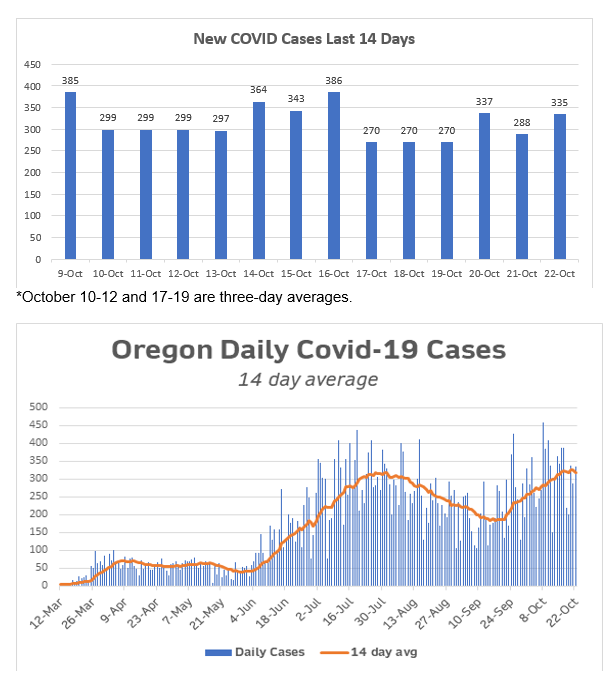 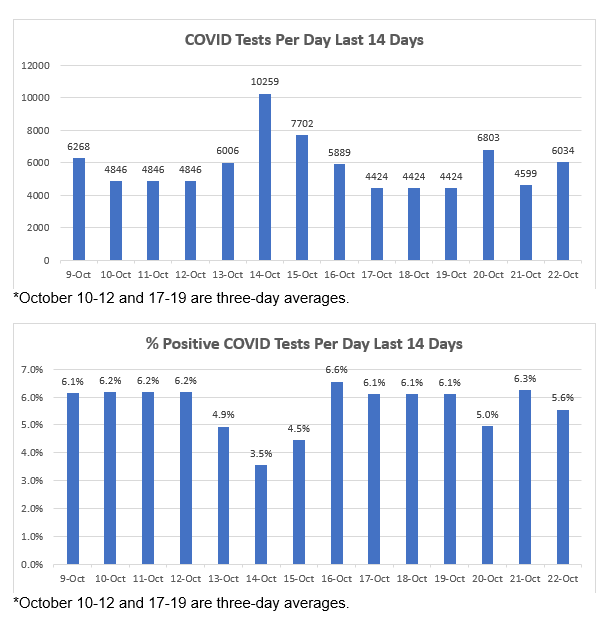 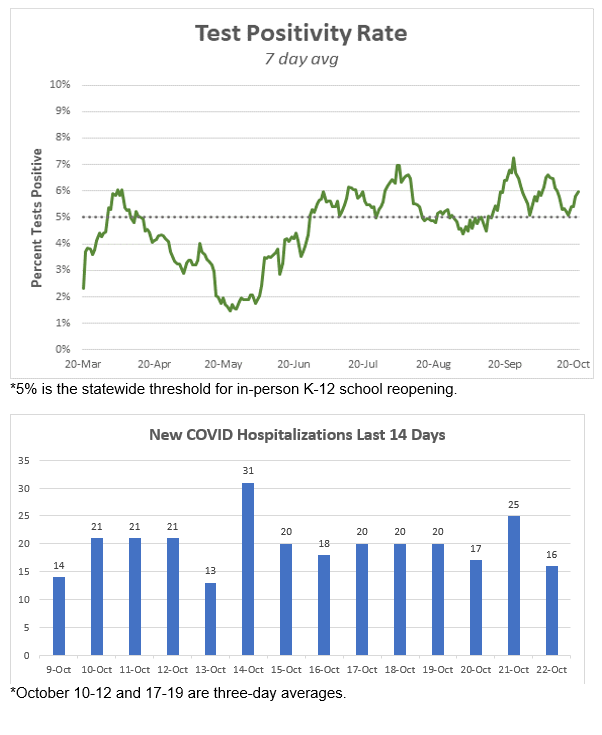 
Want to See Past Newsletters?
If there was COVID-related information in a past newsletter that you want to go back to, but find you’ve deleted it, you can always go to my legislative website (senatordembrow.com), click on “News and Information,” and you’ll find them all there. Also, if someone forwarded you this newsletter and you’d like to get it directly, you can sign up for it there.
AND FINALLY,
Here again are some resources that you will find useful:
If the above links are not providing you with answers to your questions or directing you to the help that you need, please consider me and my office to be a resource. We’ll do our best to assist you or steer you in the right direction.
Best,
 Senator Michael Dembrow
District 23
email: Sen.MichaelDembrow@oregonlegislature.gov
web: www.senatordembrow.com
phone: 503-986-1723
mail: 900 Court St NE, S-407, Salem, OR, 97301
|